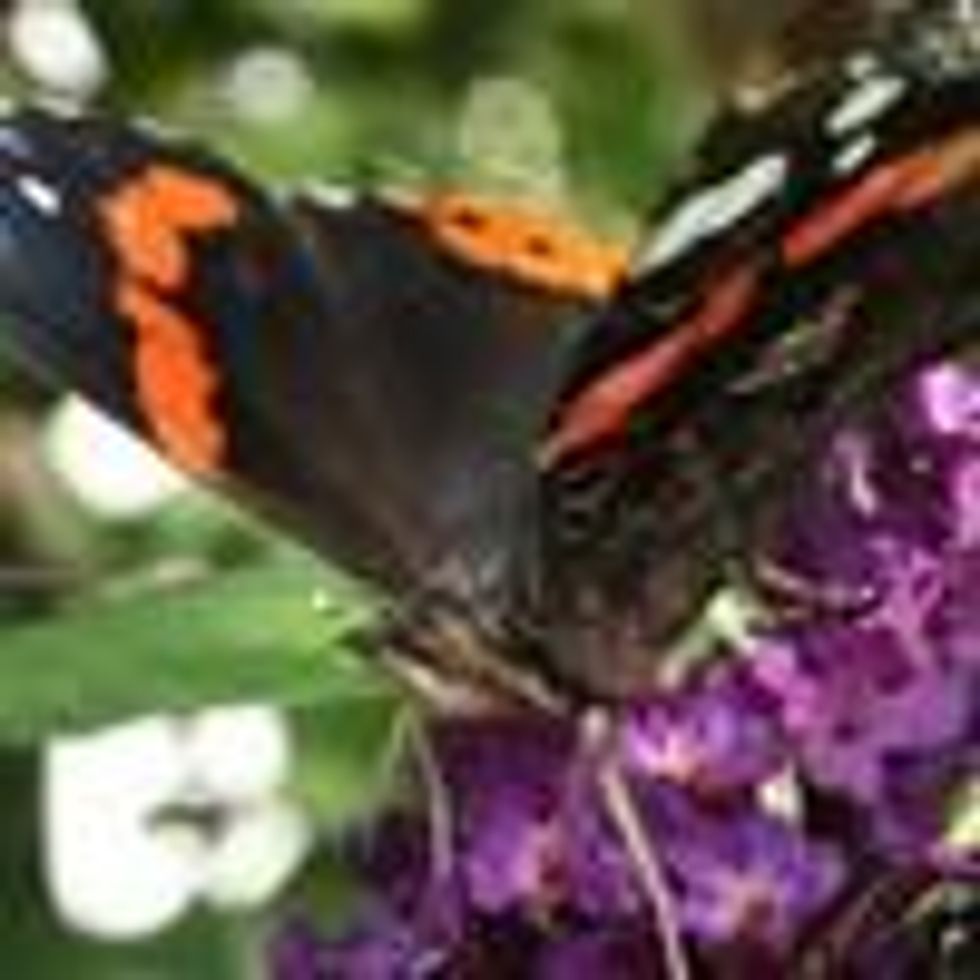

SUBSCRIBE TO OUR FREE NEWSLETTER
Daily news & progressive opinion—funded by the people, not the corporations—delivered straight to your inbox.
5
#000000
#FFFFFF
To donate by check, phone, or other method, see our More Ways to Give page.


Daily news & progressive opinion—funded by the people, not the corporations—delivered straight to your inbox.

A bee collects nectar off an almond tree near Visalia, California. Honeybees pollinate many crops, including almond trees in February, and are essential to the food chain. (Photo by Ann Johansson/Corbis via Getty Images):
The bee-killing pesticide sulfoxaflor is no longer approved for use in California after a ruling by a state superior court that environmental advocates say represents a win for pollinators and the nation's food system.
In a statement Monday noting that "just about every commercial honey bee colony in this country spends at least part of the year in California," Steve Ellis, president of the Pollinator Stewardship Council, called the ruling "incredibly important for pollinators" because "removing systemic insecticides such as sulfoxaflor will help ensure honey bees have a healthy future." That's especially crucial, he said, in light of recent "astounding losses" to honey bee colonies.
"Removing systemic insecticides such as sulfoxaflor will help ensure honey bees have a healthy future."
Represented in court by environmental law firm Earthjustice, Ellis' group joined the American Beekeeping Federation in challenging the California Department of Pesticide Regulation's (DPR) approval of sulfoxaflor, a chemical produced by Corteva, a spinoff company of the 2017 Dow-DuPont merger.
The bee advocates note that sulfoxaflor is similar to the class of pesticides known as neonicotinoids, neonics, as they are both "systemic" pesticides--making their way from root to plant tissue--and lethal to bees.
In the ruling, handed down Friday by the Alameda County Superior Court, Judge Frank Roesch agreed with the petitioners in finding that that regulators failed to provide an "adequate description of the environmental setting into which the new sulfoxaflor pesticides will be introduced" and that the "public reports do not satisfy the requirement of a meaningful consideration of alternatives."
There was also no disclosure to the public of "why the agency approved the project after consideration of the potential environmental impacts of the approval of sulfoxaflor," the ruling said.
Related Content

Earthjustice attorney Greg Loarie welcomed the decision but said that the state had more work to do to protect bees and other pollinators.
"Honeybees and other pollinators are incredibly important in our food systems and our wider ecosystem, but they're dying in droves because of pesticides like sulfoxaflor," he said in a statement. "With this ruling, the bees in California are getting much-needed relief just as we're seeing some of the worst signs of colony collapse."
"Now," he added, "California needs to turn its attention to protecting pollinators from the entire class of neonicotinoid pesticides that threaten our future.
The plaintiffs' victory came as they fight the Environmental Protection Agency's 2019 federal approval of sulfoxaflor, and as scientists continue to sound alarm about the global loss of insects--a trend linked to pesticide-dependent industrial agriculture and described as an "unnoticed apocalypse."
Trump and Musk are on an unconstitutional rampage, aiming for virtually every corner of the federal government. These two right-wing billionaires are targeting nurses, scientists, teachers, daycare providers, judges, veterans, air traffic controllers, and nuclear safety inspectors. No one is safe. The food stamps program, Social Security, Medicare, and Medicaid are next. It’s an unprecedented disaster and a five-alarm fire, but there will be a reckoning. The people did not vote for this. The American people do not want this dystopian hellscape that hides behind claims of “efficiency.” Still, in reality, it is all a giveaway to corporate interests and the libertarian dreams of far-right oligarchs like Musk. Common Dreams is playing a vital role by reporting day and night on this orgy of corruption and greed, as well as what everyday people can do to organize and fight back. As a people-powered nonprofit news outlet, we cover issues the corporate media never will, but we can only continue with our readers’ support. |
The bee-killing pesticide sulfoxaflor is no longer approved for use in California after a ruling by a state superior court that environmental advocates say represents a win for pollinators and the nation's food system.
In a statement Monday noting that "just about every commercial honey bee colony in this country spends at least part of the year in California," Steve Ellis, president of the Pollinator Stewardship Council, called the ruling "incredibly important for pollinators" because "removing systemic insecticides such as sulfoxaflor will help ensure honey bees have a healthy future." That's especially crucial, he said, in light of recent "astounding losses" to honey bee colonies.
"Removing systemic insecticides such as sulfoxaflor will help ensure honey bees have a healthy future."
Represented in court by environmental law firm Earthjustice, Ellis' group joined the American Beekeeping Federation in challenging the California Department of Pesticide Regulation's (DPR) approval of sulfoxaflor, a chemical produced by Corteva, a spinoff company of the 2017 Dow-DuPont merger.
The bee advocates note that sulfoxaflor is similar to the class of pesticides known as neonicotinoids, neonics, as they are both "systemic" pesticides--making their way from root to plant tissue--and lethal to bees.
In the ruling, handed down Friday by the Alameda County Superior Court, Judge Frank Roesch agreed with the petitioners in finding that that regulators failed to provide an "adequate description of the environmental setting into which the new sulfoxaflor pesticides will be introduced" and that the "public reports do not satisfy the requirement of a meaningful consideration of alternatives."
There was also no disclosure to the public of "why the agency approved the project after consideration of the potential environmental impacts of the approval of sulfoxaflor," the ruling said.
Related Content

Earthjustice attorney Greg Loarie welcomed the decision but said that the state had more work to do to protect bees and other pollinators.
"Honeybees and other pollinators are incredibly important in our food systems and our wider ecosystem, but they're dying in droves because of pesticides like sulfoxaflor," he said in a statement. "With this ruling, the bees in California are getting much-needed relief just as we're seeing some of the worst signs of colony collapse."
"Now," he added, "California needs to turn its attention to protecting pollinators from the entire class of neonicotinoid pesticides that threaten our future.
The plaintiffs' victory came as they fight the Environmental Protection Agency's 2019 federal approval of sulfoxaflor, and as scientists continue to sound alarm about the global loss of insects--a trend linked to pesticide-dependent industrial agriculture and described as an "unnoticed apocalypse."
The bee-killing pesticide sulfoxaflor is no longer approved for use in California after a ruling by a state superior court that environmental advocates say represents a win for pollinators and the nation's food system.
In a statement Monday noting that "just about every commercial honey bee colony in this country spends at least part of the year in California," Steve Ellis, president of the Pollinator Stewardship Council, called the ruling "incredibly important for pollinators" because "removing systemic insecticides such as sulfoxaflor will help ensure honey bees have a healthy future." That's especially crucial, he said, in light of recent "astounding losses" to honey bee colonies.
"Removing systemic insecticides such as sulfoxaflor will help ensure honey bees have a healthy future."
Represented in court by environmental law firm Earthjustice, Ellis' group joined the American Beekeeping Federation in challenging the California Department of Pesticide Regulation's (DPR) approval of sulfoxaflor, a chemical produced by Corteva, a spinoff company of the 2017 Dow-DuPont merger.
The bee advocates note that sulfoxaflor is similar to the class of pesticides known as neonicotinoids, neonics, as they are both "systemic" pesticides--making their way from root to plant tissue--and lethal to bees.
In the ruling, handed down Friday by the Alameda County Superior Court, Judge Frank Roesch agreed with the petitioners in finding that that regulators failed to provide an "adequate description of the environmental setting into which the new sulfoxaflor pesticides will be introduced" and that the "public reports do not satisfy the requirement of a meaningful consideration of alternatives."
There was also no disclosure to the public of "why the agency approved the project after consideration of the potential environmental impacts of the approval of sulfoxaflor," the ruling said.
Related Content

Earthjustice attorney Greg Loarie welcomed the decision but said that the state had more work to do to protect bees and other pollinators.
"Honeybees and other pollinators are incredibly important in our food systems and our wider ecosystem, but they're dying in droves because of pesticides like sulfoxaflor," he said in a statement. "With this ruling, the bees in California are getting much-needed relief just as we're seeing some of the worst signs of colony collapse."
"Now," he added, "California needs to turn its attention to protecting pollinators from the entire class of neonicotinoid pesticides that threaten our future.
The plaintiffs' victory came as they fight the Environmental Protection Agency's 2019 federal approval of sulfoxaflor, and as scientists continue to sound alarm about the global loss of insects--a trend linked to pesticide-dependent industrial agriculture and described as an "unnoticed apocalypse."